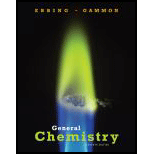
Concept explainers
Interpretation:
Distribution of d-electrons in the complex ion
Concept Introduction:
The term Crystal field splitting refers to segregation of d-orbitals in to higher energy orbitals and lower energy orbitals when ligands approaches metal ion to co-ordinate. Crystal field splitting is said to be larger when the energy gap between higher energy d-orbitals and lower energy d-orbitals is larger. Crystal field splitting is said to be smaller when the energy gap between higher energy d-orbitals and lower energy d-orbitals is smaller.
Spectrochemical series refers to the arrangement of ligands with respect to crystal field splitting they cause in the d-orbitals of a metal ion. The ligand that causes larger splitting pattern is referred to as stronger ligand.
The ligands are arranged in increasing order of crystal field splitting they produce.
The ligand that causes larger crystal field splitting is strong ligand and the ligand that causes smaller splitting is termed as weak ligand.
Pairing energy refers to the energy required to pair the electrons - that is energy required to make two electrons to be paired in same orbital with opposite spins.
If the pairing energy of a complex is high it means the electrons are difficult to be paired and so the complex will be high spin complex with unpaired electrons. If the pairing energy of a complex is low it means the electrons are readily paired and so the complex will be low spin complex with paired electrons.
A complex with high splitting energy will have low pairing energy because high splitting energy indicates larger energy gap between lower and higher energy levels that the electrons need lesser energy to be paired and they tend to remain paired in lower energy orbitals. A complex with low splitting energy will have high pairing energy because low splitting energy indicates smaller energy gap between lower and higher energy levels that the electrons disperse among orbitals more randomly and they need higher energy to be paired.
Want to see the full answer?
Check out a sample textbook solution
Chapter 22 Solutions
General Chemistry - Standalone book (MindTap Course List)
- What is the final product when D-galactose reacts with hydroxylamine?arrow_forwardIndicate the formula of the product obtained by reacting methyl 5-chloro-5-oxopentanoate with 1 mole of 4-penten-1-ylmagnesium bromide.arrow_forwardIn the two chair conformations of glucose, the most stable is the one with all the OH groups in the equatorial position. Is this correct?arrow_forward
- please help me with my homeworkarrow_forwardhelparrow_forwardThe temperature on a sample of pure X held at 1.25 atm and -54. °C is increased until the sample boils. The temperature is then held constant and the pressure is decreased by 0.42 atm. On the phase diagram below draw a path that shows this set of changes. pressure (atm) 2 0 0 200 400 temperature (K) Xarrow_forward
- QUESTION: Answer Question 5: 'Calculating standard error of regression' STEP 1 by filling in all the empty green boxes *The values are all provided in the photo attached*arrow_forwardpressure (atm) 3 The pressure on a sample of pure X held at 47. °C and 0.88 atm is increased until the sample condenses. The pressure is then held constant and the temperature is decreased by 82. °C. On the phase diagram below draw a path that shows this set of changes. 0 0 200 temperature (K) 400 аarrow_forwarder your payment details | bar xb Home | bartleby x + aleksogi/x/isl.exe/1o u-lgNskr7j8P3jH-1Qs_pBanHhviTCeeBZbufuBYT0Hz7m7D3ZcW81NC1d8Kzb4srFik1OUFhKMUXzhGpw7k1 O States of Matter Sketching a described thermodynamic change on a phase diagram 0/5 The pressure on a sample of pure X held at 47. °C and 0.88 atm is increased until the sample condenses. The pressure is then held constant and the temperature is decreased by 82. °C. On the phase diagram below draw a path that shows this set of changes. pressure (atm) 1 3- 0- 0 200 Explanation Check temperature (K) 400 X Q Search L G 2025 McGraw Hill LLC. All Rights Reserved Terms of Use Privacy Cearrow_forward
 Chemistry: The Molecular ScienceChemistryISBN:9781285199047Author:John W. Moore, Conrad L. StanitskiPublisher:Cengage Learning
Chemistry: The Molecular ScienceChemistryISBN:9781285199047Author:John W. Moore, Conrad L. StanitskiPublisher:Cengage Learning
